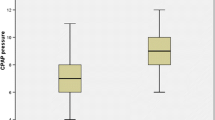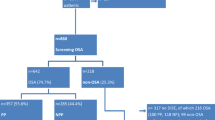Abstract
Purpose
Drug-induced sleep endoscopy (DISE) is commonly performed in patients suffering obstructive sleep apnea (OSA) with continuous positive airway pressure (CPAP) intolerance. We aimed to evaluate the effects of adding CPAP to DISE to provide understanding of the reason of its failure and better guidance in future therapeutic decisions.
Methods
A retrospective observational descriptive study was conducted on CPAP-intolerant patients with moderate-severe OSA. DISE was used to evaluate upper airway collapsibility, and CPAP was tested to better describe anatomical sites of obstruction and to measure the opening pharyngeal pressure.
Results
Sample size consisted of 38 patients with a mean age of 49 ± 9 years. Mean BMI was 28.4 ± 2.4 kg/m2, mean apnea–hypopnea index (AHI) was 35.4 events per hour ± 20.1, and mean saturation under 90% (TSat90) was 14.5%. In DISE we found a collapse at Velum in 92% of patients, at Oropharyngeal level in 89%, at tongue in 42%, and at epiglottis in 36%. In the subgroup of patients with clinical failure with CPAP, we observed 100% of epiglottic collapse and 50% of tongue obstruction. In this specific population, we recommended personalized surgery and myofunctional therapy.
Conclusion
DISE-CPAP is a useful tool to select the treatment that better fits to each patient taking care all information available. It improves our ability to prescribe a multilevel treatment with an exhaustive topographic evaluation of upper airway collapsibility that complements CPAP classic titration, and it can be helpful to distinguish better candidates for surgery, myofunctional therapy or CPAP.



Similar content being viewed by others
Data availability
We could provide the database available to revise if needed.
References
Bosi M, De Vito A, Kotecha B, Viglietta L, Braghiroli A, Steier J, Pengo M, Sorrenti G, Gobbi R, Vicini C, Poletti V (2018) Phenotyping the pathophysiology of obstructive sleep apnea using polygraphy/polysomnography: a review of the literature. Sleep Breath 22:579–592. https://doi.org/10.1007/s11325-017-1613-3
Enright PL, Newman AB, Wahl PW, Manolio TA, Haponik FE, Boyle PJR (1996) Prevalence and correlates of snoring and observed apneas in 5,201 older adults. Sleep 19(7):531–538
Gislason T, Almqvist M, Eriksson G, Taube A, Boman G (1988) Prevalence of sleep apnea syndrome among Swedish men an epidemiological study. J Clin Epidemiol 41(6):571–576
Mediano O, GonzálezMangado N, Montserrat JM, Alonso-Álvarez MA, Almendros I, Alonso-Fernández A, Barbé F, Borsini E et al (2022) Spanish sleep. Network international consensus document on obstructive sleep apnea. Arch Bronconeumol 58(1):52–68. https://doi.org/10.1016/j.arbres.2021.03.017. (English, Spanish)
Chang JL, Goldberg AN, Alt JA, Alzoubaidi M, Ashbrook L, Bakhtiar H, Ayappa I, Auckley D et al (2023) International consensus statement on obstructive sleep apnea. Int Forum Allergy Rhinol 13(7):1061–1482. https://doi.org/10.1002/alr.23079
Weaver TE, Sawyer AM (2010) Adherence to continuous positive airway pressure treatment for obstructive sleep apnoea: implications for future interventions. Indian J Med Res 131:245–258
Weaver TE, Grunstein RR (2008) Adherence to continuous positive airway pressure therapy: the challenge to effective treatment. Proc Am Thorac Soc 5(2):173–178
Rotenberg BW, Murariu D, Pang KP (2016) Trends in CPAP adherence over twenty years of data collection: a flattened curve. J Otolaryngol Head Neck Surg 45(1):43
Dieleman E, Veugen CCAFM, Hardeman JA, Copper MP (2021) Drug-induced sleep endoscopy while administering CPAP therapy in patients with CPAP failure. Sleep Breath 25(1):391–398
Torre C, Liu SY, Kushida CA et al (2017) Impact of continuous positive airway pressure in patients with obstructive sleep apnea during drug-induced sleep endoscopy. Clin Otolaryngol 42(6):1218–1223
Ramírez Merlano SA, Repetto GP, Durán RA, Silva JA, Saldaña RL (2023) Relationship between level CPAP titration, anthropometric variables, and drug-induced sleep endoscopy DISE. Eur Arch Otorhinolaryngol 280(3):1353–1359
Jung SH, Koo SK, Choi JW, Moon JS, Lee SH (2017) Upper airway structural changes induced by CPAP in OSAS patients: a study using drug-induced sleep endoscopy. Eur Arch Otorhinolaryngol 274(1):247–252. https://doi.org/10.1007/s00405-016-4233-9. (Epub 2016 Jul 29)
Yu JL, Thuler E, Seay EG, Schwartz AR, Dedhia RC (2023) The accuracy and reliability of visually assessed pharyngeal opening pressures during drug-induced sleep endoscopy. Otolaryngol Head Neck Surg 168(4):868–875. https://doi.org/10.1177/01945998221120793
Friedman M (2009) Chapt 16: Friedman tongue position and the staging of obstructive sleep apnea/hypopnea syndrome. In: Friedman M (ed) Sleep apnea and snoring: surgical and non-surgical therapy. Saunders Elsevier, Philadelphia
Morato M, Cardona-Sosa MP, Bosco G, Pérez-Martín N, Marte-Bonilla MM, Marco A, O’Connor-Reina C, Lugo R, Plaza G (2023) Palatopharyngeal arch staging system (PASS): consensus about oropharyngeal evaluation. Life 13(3):709. https://doi.org/10.3390/life13030709
Rodríguez-Alcalá L, Benjumea F, Casado-Morente JC, Baptista PM, O’Connor-Reina C, Plaza G (2022) Evaluation of the muscle strength of the tongue with the tongue digital spoon (TDS) in patients with obstructive sleep apnea. Life (Basel) 12(11):1841. https://doi.org/10.3390/life12111841
Kezirian EJ, Hohenhorst W, de Vries N (2011) Drug-induced sleep endoscopy: the VOTE classification. Eur Arch Otorhinolaryngol 268(8):1233–1236
Fernández-Sanjuán P, Arrieta JJ, Sanabria J, Alcaraz M, Bosco G, Pérez-Martín N, Pérez A, Carrasco-Llatas M, Moreno-Hay I, Ríos-Lago M, Lugo R, O’Connor-Reina C, Baptista P, Plaza G (2022) Optimizing mandibular advancement maneuvers during sleep endoscopy with a titratable positioner: DISE-SAM protocol. J Clin Med 11(3):658. https://doi.org/10.3390/jcm11030658
O’Connor-Reina C, Ignacio Garcia JM, Rodriguez Ruiz E, Morillo Dominguez MDC, Ignacio Barrios V, Baptista Jardin P, Casado Morente JC, Garcia Iriarte MT, Plaza G (2020) Myofunctional therapy app for severe apnea-hypopnea sleep obstructive syndrome: pilot randomized controlled trial. JMIR Mhealth Uhealth 8(11):e23123
Sforza E, Petiau C, Weiss T, Thibault A, Krieger J (1999) Pharyngeal critical pressure in patients with obstructive sleep apnea syndrome: clinical implications. Am J Respir Crit Care Med 159(1):149–157. https://doi.org/10.1164/ajrccm.159.1.9804140
Sutherland K, Phillips CL, Davies A et al (2014) CPAP pressure for prediction of oral appliance treatment response in obstructive sleep apnea. J Clin Sleep Med 10(9):943–949. https://doi.org/10.5664/jcsm.4020
Vroegop AV, Vanderveken OM, Dieltjens M, Wouters K, Saldien V, Braem MJ, Van de Heyning PH (2013) Sleep endoscopy with simulation bite for prediction of oral appliance treatment outcome. J Sleep Res 22:348–355. https://doi.org/10.1111/jsr.12008
Masárová M, Matoušek P, Jor O et al (2022) Sleep endoscopy with positive airway pressure: a method for better compliance and individualized treatment of patients with obstructive sleep apnea. Life (Basel) 12(12):2108
Schwartz AR, Schubert N, Rothman W et al (1992) Effect of uvulopalatopharyngoplasty on upper airway collapsibility in obstructive sleep apnea. Am Rev Respir Dis 145(3):527–532. https://doi.org/10.1164/ajrccm/145.3.527
Raj A, Bansal S, Dhooria S, Jain D, Virk RS, Panda NK (2023) Drug-induced sleep endoscopy-continuous positive airway pressure (DISE-CPAP), a newer modality to choose the right candidates for CPAP. Sleep Breath 27(5):1787–1794. https://doi.org/10.1007/s11325-023-02787-3. (Epub 2023 Feb 8)
Malhotra A, Pillar G, Fogel R, Beauregard J, Edwards J, White DP (2001) Upper-airway collapsibility: measurements and sleep effects. Chest 120:156–161. https://doi.org/10.1378/chest.120.1.156
Osman AM, Carberry JC, Burke PGR, Toson B, Grunstein RR, Eckert DJ (2019) Upper airway collapsibility measured using a simple wakefulness test closely relates to the pharyngeal critical closing pressure during sleep in obstructive sleep apnea. Sleep 42:zsz080. https://doi.org/10.1093/sleep/zsz080
Hirata RP, Schorr F, Kayamori F, Moriya HT, Romano S, Insalaco G, Gebrim EM, de Oliveira LV, Genta PR, Lorenzi-Filho G (2016) Upper airway collapsibility assessed by negative expiratory pressure while awake is associated with upper airway anatomy. J Clin Sleep Med 12:1339–1346. https://doi.org/10.5664/jcsm.6184
Azarbarzin A, Sands SA, Taranto-Montemurro L, Oliveira Marques MD, Genta PR, Edwards BA, Butler J, White DP, Wellman A (2017) Estimation of pharyngeal collapsibility during sleep by peak inspiratory airflow. Sleep 40:zsw005. https://doi.org/10.1093/sleep/zsw005
Dedhia RC, Seay EG, Schwartz AR (2021) Beyond VOTE: the new frontier of drug-induced sleep endoscopy. ORL J Otorhinolaryngol Relat Spec. https://doi.org/10.1159/000518660
Seay EG, Keenan BT, Schwartz AR, Dedhia RC (2020) Evaluation of therapeutic positive airway pressure as a hypoglossal nerve stimulation predictor in patients with obstructive sleep apnea. JAMA Otolaryngol Head Neck Surg 146(8):691–698. https://doi.org/10.1001/jamaoto.2020.1018
Torre C, Camacho M, Liu SYC, Huon LK, Capasso R (2016) Epiglottis collapse in adult obstructive sleep apnea: a systematic review. Laryngoscope 126(2):515–523
Hutz MJ, LoSavio P (2022) Practical implementation of sleep endoscopy with positive airway pressure in clinical practice. Laryngoscope. https://doi.org/10.1002/lary.30272
Yui MS, Tominaga Q, Lopes BCP, Eckeli AL, Rabelo FAW, Küpper DS, Valera FCP (2020) Nasal vs. oronasal mask during PAP treatment: a comparative DISE study. Sleep Breath. 24(3):1129–1136. https://doi.org/10.1007/s11325-019-01976-3. (Epub 2019 Dec 3)
Funding
This research received no external funding.
Author information
Authors and Affiliations
Corresponding author
Ethics declarations
Conflict of interest
All authors certify that they have no affiliation or involvement with any organization or entity that has any financial or non-financial interest in the subject matter or materials discussed in this manuscript.
Ethical approval
The study was conducted according to the guidelines of the Declaration of Helsinki. The Research Ethics Committee of the hospital approved the study protocol (IRB 23/71).
Additional information
Publisher's Note
Springer Nature remains neutral with regard to jurisdictional claims in published maps and institutional affiliations.
Rights and permissions
Springer Nature or its licensor (e.g. a society or other partner) holds exclusive rights to this article under a publishing agreement with the author(s) or other rightsholder(s); author self-archiving of the accepted manuscript version of this article is solely governed by the terms of such publishing agreement and applicable law.
About this article
Cite this article
Morato, M., Alcaraz, M., Bosco, G. et al. DISE with CPAP: a useful procedure to evaluate upper airway collapsibility. Eur Arch Otorhinolaryngol (2024). https://doi.org/10.1007/s00405-024-08618-9
Received:
Accepted:
Published:
DOI: https://doi.org/10.1007/s00405-024-08618-9




